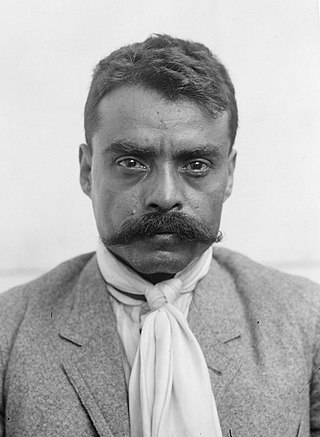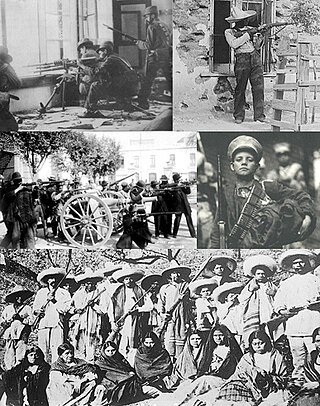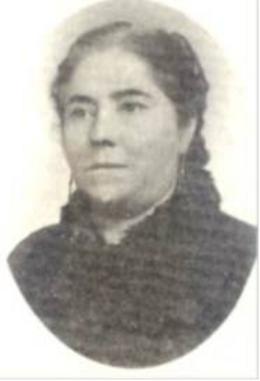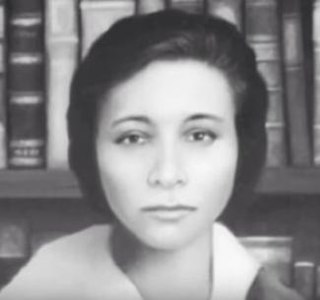Related Research Articles

Emiliano Zapata Salazar was a Mexican revolutionary. He was a leading figure in the Mexican Revolution of 1910–1920, the main leader of the people's revolution in the Mexican state of Morelos, and the inspiration of the agrarian movement called Zapatismo.

The Mexican Revolution was an extended sequence of armed regional conflicts in Mexico from approximately 1910 to 1920. It has been called "the defining event of modern Mexican history". It resulted in the destruction of the Federal Army and its replacement by a revolutionary army, and the transformation of Mexican culture and government. The northern Constitutionalist faction prevailed on the battlefield and drafted the present-day Constitution of Mexico, which aimed to create a strong central government. Revolutionary generals held power from 1920 to 1940. The revolutionary conflict was primarily a civil war, but foreign powers, having important economic and strategic interests in Mexico, figured in the outcome of Mexico's power struggles; the U.S. involvement was particularly high. The conflict led to the deaths of around two million people, mostly combatants.
Women's suffrage is the right of women to vote in elections. In the beginning of the 18th century, some people sought to change voting laws to allow women to vote. Liberal political parties would go on to grant women the right to vote, increasing the number of those parties' potential constituencies. National and international organizations formed to coordinate efforts towards women voting, especially the International Woman Suffrage Alliance.
This is an index of articles related to the issue of feminism, women's liberation, the women's movement, and women's rights.
First-wave feminism was a period of feminist activity and thought that occurred during the 19th and early 20th century throughout the Western world. It focused on legal issues, primarily on securing women's right to vote. The term is often used synonymously with the kind of feminism espoused by the liberal women's rights movement with roots in the first wave, with organizations such as the International Alliance of Women and its affiliates. This feminist movement still focuses on equality from a mainly legal perspective.

The military history of Mexico encompasses armed conflicts within that nation's territory, dating from before the arrival of Europeans in 1519 to the present era. Mexican military history is replete with small-scale revolts, foreign invasions, civil wars, indigenous uprisings, and coups d'état by disgruntled military leaders. Mexico's colonial-era military was not established until the eighteenth century. After the Spanish conquest of the Aztec Empire in the early sixteenth century, the Spanish crown did not establish on a standing military, but the crown responded to the external threat of a British invasion by creating a standing military for the first time following the Seven Years' War (1756–63). The regular army units and militias had a short history when in the early 19th century, the unstable situation in Spain with the Napoleonic invasion gave rise to an insurgency for independence, propelled by militarily untrained, darker complected men fighting for the independence of Mexico. The Mexican War of Independence (1810–21) saw royalist and insurgent armies battling to a stalemate in 1820. That stalemate ended with the royalist military officer turned insurgent, Agustín de Iturbide persuading the guerrilla leader of the insurgency, Vicente Guerrero, to join in a unified movement for independence, forming the Army of the Three Guarantees. The royalist military had to decide whether to support newly independent Mexico. With the collapse of the Spanish state and the establishment of first a monarchy under Iturbide and then a republic, the state was a weak institution. The Roman Catholic Church and the military weathered independence better. Military men dominated Mexico's nineteenth-century history, most particularly General Antonio López de Santa Anna, under whom the Mexican military were defeated by Texas insurgents for independence in 1836 and then the U.S. invasion of Mexico (1846–48). With the overthrow of Santa Anna in 1855 and the installation of a government of political liberals, Mexico briefly had civilian heads of state. The Liberal Reforms that were instituted by Benito Juárez sought to curtail the power of the military and the church and wrote a new constitution in 1857 enshrining these principles. Conservatives comprised large landowners, the Catholic Church, and most of the regular army revolted against the Liberals, fighting a civil war. The Conservative military lost on the battlefield. But Conservatives sought another solution, supporting the French intervention in Mexico (1862–65). The Mexican army loyal to the liberal republic were unable to stop the French army's invasion, briefly halting it in with a victory at Puebla on 5 May 1862. Mexican Conservatives supported the installation of Maximilian Hapsburg as Emperor of Mexico, propped up by the French and Mexican armies. With the military aid of the U.S. flowing to the republican government in exile of Juárez, the French withdrew its military supporting the monarchy and Maximilian was caught and executed. The Mexican army that emerged in the wake of the French Intervention was young and battle tested, not part of the military tradition dating to the colonial and early independence eras.

"La Adelita" is one of the most famous corridos of the Mexican Revolution. Over the years, it has had many adaptations. The ballad was inspired by a Chihuahuense woman who joined the Maderista movement in the early stages of the revolution and fell in love with Madero. She became a popular icon and a symbol of the role of women in the Mexican Revolution. The figure of the adelita gradually became synonymous with the term soldadera, the woman in a military-support role, who became a vital force in the revolutionary efforts through provisioning, espionage, and other activities in the battles against Mexican federal government forces.

Soldaderas, often called Adelitas, were women in the military who participated in the conflict of the Mexican Revolution, ranging from commanding officers to combatants to camp followers. "In many respects, the Mexican revolution was not only a men's but a women's revolution." Although some revolutionary women achieved officer status, coronelas, "there are no reports of a woman achieving the rank of general." Since revolutionary armies did not have formal ranks, some women officers were called generala or coronela, even though they commanded relatively few men. A number of women took male identities, dressing as men, and being called by the male version of their given name, among them Ángel Jiménez and Amelio Robles Ávila.
Las Adelitas de Aztlán was a short-lived Mexican American female civil rights organization that was created by Gloria Arellanes and Gracie and Hilda Reyes in 1970. Gloria Arellanes and Gracie and Hilda Reyes were all former members of the Brown Berets, another Mexican American Civil rights organization that had operated concurrently during the 1960s and 1970s in the California area. The founders left the Brown Berets due to enlarging gender discrepancies and disagreements that caused much alienation amongst their female members. The Las Adelitas De Aztlan advocated for Mexican-American Civil rights, better conditions for workers, protested police brutality and advocated for women's rights for the Latino community. The name of the organization was a tribute to Mexican female soldiers or soldaderas that fought during the Mexican Revolution of the early twentieth century.
The history of feminism in Canada has been a gradual struggle aimed at establishing equal rights. The history of Canadian feminism, like modern Western feminism in other countries, has been divided by scholars into four "waves", each describing a period of intense activism and social change. The use of "waves" has been critiqued for its failure to include feminist activism of Aboriginal and Québécois women who organized for changes in their own communities as well as for larger social change.

Elvia Carrillo Puerto was a Mexican socialist politician and feminist activist. Carrillo had been married by the age of 13 and widowed by 21. She founded some of Mexico's first feminist organizations, including the League of Rita Cetina Gutierrez in 1919. In 1923, Carillo became Mexico's first woman state deputy when she was elected to the Chamber of Deputies. Due to Carrillo's contributions to Mexican government and history, she was officially honored as a "Veteran of the Revolution." Carillo's tireless dedication to the revolution and women's movement earned her the nickname "The Red Nun".

Hermila Galindo Acosta was a Mexican feminist and a writer. She was an early supporter of many radical feminist issues, primarily sex education in schools, women's suffrage, and divorce. She was one of the first feminists to state that Catholicism in Mexico was thwarting feminist efforts, and was the first woman to run for elected office in Mexico.
The status of women in Mexico has changed significantly over time. Until the twentieth century, Mexico was an overwhelmingly rural country, with rural women's status defined within the context of the family and local community. With urbanization beginning in the sixteenth century, following the Spanish conquest of the Aztec empire, cities have provided economic and social opportunities not possible within rural villages. Roman Catholicism in Mexico has shaped societal attitudes about women's social role, emphasizing the role of women as nurturers of the family, with the Virgin Mary as a model. Marianismo has been an ideal, with women's role as being within the family under the authority of men. In the twentieth century, Mexican women made great strides towards a more equal legal and social status. In 1953 women in Mexico were granted the right to vote in national elections.
Feminism in Mexico is the philosophy and activity aimed at creating, defining, and protecting political, economic, cultural, and social equality in women's rights and opportunities for Mexican women. Rooted in liberal thought, the term feminism came into use in late nineteenth-century Mexico and in common parlance among elites in the early twentieth century. The history of feminism in Mexico can be divided chronologically into a number of periods with issues. For the conquest and colonial eras, some figures have been re-evaluated in the modern era and can be considered part of the history of feminism in Mexico. At the time of independence in the early nineteenth century, there were demands that women be defined as citizens. The late nineteenth century saw the explicit development of feminism as an ideology. Liberalism advocated secular education for both girls and boys as part of a modernizing project, and women entered the workforce as teachers. Those women were at the forefront of feminism, forming groups that critiqued existing treatment of women in the realms of legal status, access to education, and economic and political power. More scholarly attention is focused on the Revolutionary period (1915–1925), although women's citizenship and legal equality were not explicitly issues for which the revolution was fought. The Second Wave and the post-1990 period have also received considerable scholarly attention. Feminism has advocated for the equality of men and women, but middle-class women took the lead in the formation of feminist groups, the founding of journals to disseminate feminist thought, and other forms of activism. Working-class women in the modern era could advocate within their unions or political parties. The participants in the Mexico 68 clashes who went on to form that generation's feminist movement were predominantly students and educators. The advisers who established themselves within the unions after the 1985 earthquakes were educated women who understood the legal and political aspects of organized labor. What they realized was that to form a sustained movement and attract working-class women to what was a largely middle-class movement, they needed to utilize workers' expertise and knowledge of their jobs to meld a practical, working system. In the 1990s, women's rights in indigenous communities became an issue, particularly in the Zapatista uprising in Chiapas. Reproductive rights remain an ongoing issue, particularly since 1991, when the Catholic Church in Mexico was no longer constitutionally restricted from being involved in politics.

María Rosa Torre González was born in the state of Yucatán, Mexico. She was the first woman in Mexico to hold an elected office.
Gerónima Sofía Villa de Buentello was a Mexican feminist who worked in the first wave of the suffrage movement in Mexico and was one of the first women to analyze the legal equality of men and women before the law. She founded the Women of the [Hispanic] race and led the faction of more moderate feminists in the 1920s in Mexico.

Latin American feminism is a collection of movements aimed at defining, establishing, and achieving equal political, economic, cultural, personal, and social rights for Latin American women. This includes seeking to establish equal opportunities for women in education and employment. People who practice feminism by advocating or supporting the rights and equality of women are feminists.
Women's suffrage in the Spanish Second Republic period was the result of efforts dating back to the mid-1800s. Women and men working towards universal suffrage had to combat earlier feminist goals that prioritized social goals, including access to education, political rights such as a woman's right to vote and equal wages. As a middle class developed and women gained more access to education, they began to focus more on the issue of suffrage but this was often around specific ideological philosophies; it was not tied into a broader working class movement calling for women's emancipation.
La Mujer Moderna was a Mexican weekly feminist magazine founded by Hermila Galindo and published between 1915 and 1919. Between September 16, 1915 and September 16, 1919, 102 issues were published in México City, México. The magazine had weekly, then monthly publications. The name La Mujer Moderna was changed to Mujer Moderna as time progressed .La Mujer Moderna aimed to advance women’s suffrage, promoting constitutionalism, political participation in the Mexican Revolution, and re-defining conditions for women in society.

The First Feminist Congress of Yucatán was a gathering of Mexican feminists that happened in 1916. The delegates gathered at the José Peón Contreras Theater in Mérida, Yucatán, Mexico from January 13 to 16. It was held under the auspices of the Yucatecan government. The Mexican government and historians largely consider it the first of its kind in the country. It was the second to be held in all of Latin America and the Caribbean, the first held in Argentina in 1910.
References
- ↑ Morton, Ward M. Woman Suffrage in Mexico. Gainesville: University of Florida Press 1962, p. 1.
- ↑ María Elena Manzanera del Campo, La igualdad de derechos políticos. Mexico DF: 1953, p. 143.
- ↑ quoted in Morton, Woman Suffrage in Mexico, p. 2.
- 1 2 3 4 5 Morton, Woman Suffrage in Mexico, p. 2.
- 1 2 3 Arroyo, Antonio Vanegas; Posada, José Guadalupe; Mendoza, Lydia; Records, Arhoolie; Band, Patrick Conway\'s; Collection, Seffens; Useta, Jorge; Alvarado, Salvador; González, Pablo. "Viewpoints on Women in the Revolution - The Mexican Revolution and the United States | Exhibitions - Library of Congress". www.loc.gov. Retrieved 2021-11-07.
- 1 2 Hohman, Maura. "When Women Took Up Arms (and Disguises) to Fight in Mexico's Revolution". HISTORY. Retrieved 2021-11-07.
- 1 2 3 Sirouyan, Cristian (2020-04-02). "La historia de Valentina Ramírez Avitia, la 'Mulán mexicana', heroína de la Revolución cuyo nombre dio origen a la famosa salsa". Clarín (in Spanish). Retrieved 2021-11-07.
- 1 2 "Valentina Ramírez Avitia: así fue la Mulan mexicana". GQ (in Mexican Spanish). 2020-04-03. Retrieved 2021-11-07.
- ↑ "La Adelita". El Universal (in Spanish). 2017-11-18. Retrieved 2021-11-07.
- ↑ Morton, Woman Suffrage in Mexico, p. 3.
- 1 2 3 4 Albertos, Ancona, & Samboa Espinosa, Antonio & José (January 17, 1916). "Diario Oficial Del Gobierno Constitucionalista Del Estado De Yucatán (República Mexicana)" (PDF). Primer-Congreso-Feminista-de-Yucatán.pdf. Gobierno del Estado de Yucatán. Archived (PDF) from the original on October 24, 2015. Retrieved March 10, 2023.
{{cite web}}: CS1 maint: multiple names: authors list (link) - 1 2 3 4 "Salvador Alvarado, the great statesman of the Revolution". Mexicanist. 2021-10-05. Retrieved 2021-11-07.
- ↑ Kif Augustine-Adams, "Women's Suffrage, the Anti-Chinese Campaigns, and Gendered Ideals in Sonora, Mexico 1917–1925." Hispanic American Historical Review 97(2)2017 pp. 226–28.
- 1 2 3 4 5 6 Boils, Guillermo. "The 1968 Student Movement And Gender Equality" (PDF). Voices of Mexico.
- 1 2 "Zapatismo and the Emergence of Indigenous Feminism". NACLA. Retrieved 2023-03-03.
- ↑ "The Zapatista Movement: The Fight for Indigenous Rights in Mexico". Australian Institute of International Affairs. Retrieved 2023-03-03.
- ↑ "Sixth Declaration of the Selva Lacandona". Enlace Zapatista (in Spanish). 2010-05-10. Retrieved 2023-03-10.
- 1 2 "The Zapatista Movement: The Fight for Indigenous Rights in Mexico". Australian Institute of International Affairs. Retrieved 2023-03-10.
- ↑ "A Spark of Hope: The Ongoing Lessons of the Zapatista Revolution 25 Years On". NACLA. Retrieved 2023-03-10.
- 1 2 "A Spark of Hope: The Ongoing Lessons of the Zapatista Revolution 25 Years On". NACLA. Retrieved 2023-03-03.
- ↑ "Community Gender Emergency: Indigenous women's response to multiple forms of violence and territorial dispossession in Mexico - IWGIA - International Work Group for Indigenous Affairs". www.iwgia.org. Retrieved 2023-03-10.
- ↑ "October 17, 1953: Women get the right to vote in Mexico". Gobierno De Mexico. Relaciones Exteriores. 2016-10-18. Retrieved 2020-11-04.
Yucatan was the first state to recognize women's right to vote in 1923.
- 1 2 3 4 5 6 Rappaport, Helen (2001). Encyclopedia of women social reformers . Santa Barbara, Calif. [u.a.]: ABC-CLIO. pp. 249–50. ISBN 978-1-57607-101-4.
- ↑ Osten, Sarah (June 2014). "A Crooked Path to the Franchise: The Historical Legacies of Mexico's Failed 1937 Women's Suffrage Amendment". The Latin Americanist. 58 (2): 97–117. doi:10.1111/tla.12028. S2CID 143353326.
- ↑ Secretaría de Relaciones Exteriores (2016-10-18). "October 17, 1953: Women get the right to vote in Mexico". Gobierno De Mexico. Relaciones Exteriores. Retrieved 2020-11-04.
Later, in 1947, President Miguel Alemán proposed a constitutional amendment that would let women exercise their right to participate in municipal elections.
- ↑ Sarah A. Buck, "The Meaning of the Women's Vote in Mexico, 1917–1953" in The Women's Revolution in Mexico, 1910–1953, Stephanie Mitchell and Patience A. Schell, eds. New York: Rowman and Littlefield 2007, pp. 73–98.
- ↑ Morton, Ward M. Woman Suffrage in Mexico. Gainesville: University of Florida Press 1962